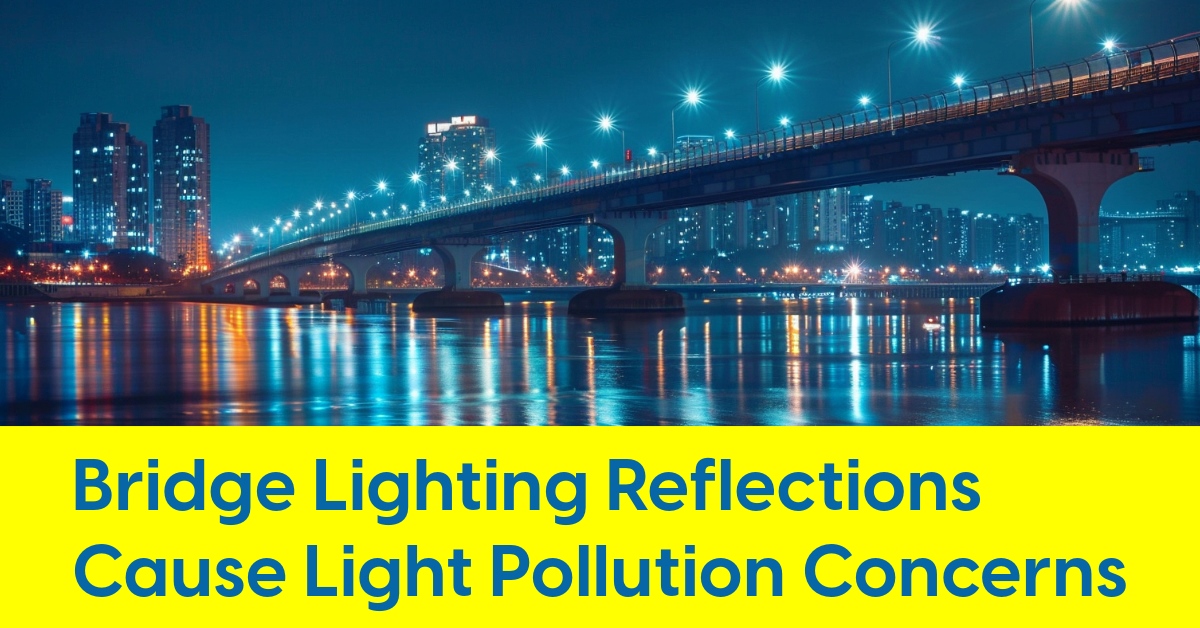May 27, 2024
Bridge Lighting Reflections Cause Light Pollution Concerns

Unshielded lighting on bridges was found to be significant contributor to polarized light pollution
Researchers have conducted an in-depth study on light pollution caused by illuminated bridges in Berlin. By examining seven bridges spanning the river Spree, the study uncovers the significant impact of artificial night lighting on the polarization of light reflected from water surfaces. This phenomenon interferes with the natural polarization created by moonlight, which nocturnal aquatic insects rely on for navigation and habitat detection.
This type of light pollution, known as polarized light pollution, can significantly disrupt natural polarization signals, altering the behavior of insects that rely on them. The research was led by Catherine Pérez Vega of the Leibniz Institute of Freshwater Ecology and Inland Fisheries.
The purpose of the research was to quantify the extent of polarized light pollution and understand its ecological implications. The findings show that a portion of the water surfaces near the studied bridges were highly polluted by polarized light, disrupting the natural light signals insects use to locate suitable habitats for activities such as mating and egg-laying. This pollution poses a threat to aquatic ecosystems, highlighting the need for better urban lighting design and management to protect these sensitive environments.
Measuring the Light Pollution
The study examined polarized light pollution, which refers to the distortion of natural light signals caused by artificial light at night. When artificial light reflects off water surfaces, it can become polarized, meaning its waves align in a particular direction.
Researchers quantified polarized light pollution at the water surfaces of seven illuminated bridges in Berlin. Researchers found that, on average, around 9% of the water surfaces near these bridges were highly polluted by polarized light, with pollution levels ranging from 3% to 13%. This type of light pollution significantly impacts aquatic insects, particularly those that rely on polarized light as a navigational cue.
The study determined that altered light conditions can mislead insects such as mayflies, causing them to mistake artificial reflections for natural water bodies, which can lead to disrupted mating and egg-laying behaviors. The findings highlight the ecological threat posed by polarized light pollution and highlight the need for improved lighting practices to mitigate its effects on aquatic ecosystems.
Sources and Impacts of Polarized Light Pollution
The study identified that both functional and decorative lighting on bridges produced horizontally polarized light when reflected off the water surface, contributing to significant levels of polarized light pollution. This type of lighting, including streetlights for pedestrians and vehicles as well as aesthetic illumination, creates strong polarizing effects that alter the natural light environment of the river. Additionally, urban illumination from nearby buildings, even when not directly visible from the measurement positions, added to the overall polarized light pollution. The reflections from these sources interfere with the natural polarization signals that nocturnal aquatic insects rely on for navigation.
Unshielded lighting on bridges was found to be a major contributor to polarized light pollution. The lack of shielding allows light to scatter widely and reflect off the water surface, creating misleading visual cues for aquatic insects. Nearby building lights also played a significant role, with reflections from illuminated facades and interiors adding to the pollution levels. These sources of artificial light can mislead insects such as mayflies, causing them to mistake artificial reflections for natural water bodies, which can disrupt their natural behaviors and lead to ecological consequences.
Recommendations
The study offers several detailed recommendations to mitigate the impacts of polarized light pollution on aquatic ecosystems:
"To protect organisms sensitive to reflected polarized light, it is recommended that the emission of luminaires shall not exceed the intended functional range, and, if possible, the water bodies should remain unlit throughout the night by shielding solutions for luminaires" (Pérez Vega et al., 2024)
Implement Proper Shielding: Urban lighting, particularly on bridges, should be properly shielded to prevent light from directly reaching water surfaces. Shielding can significantly reduce the amount of light that gets polarized upon reflection, thereby minimizing the misleading cues for aquatic insects.
Design Adjustments: Urban lighting design should consider the ecological impact of light polarization. Lighting fixtures should be oriented and designed to minimize the emission of short wavelengths, which are more likely to be polarized and attract insects. Using warmer light colors can also help reduce polarization effects.
Reduce Light Intensity and Duration: Lowering the intensity and limiting the duration of artificial lighting, especially near water bodies, can help reduce the overall light pollution. The study noted, “improving luminance distribution or reducing light intensity and duration are likely to be more effective in minimizing the negative impacts of polarized light.”
The findings emphasize the need for better lighting design and management to minimize the impacts of polarized light pollution on aquatic ecosystems.
RESEARCH CITATIONS:
“Polarised Light Pollution on River Water Surfaces Caused by Artificial Light at Night from Illuminated Bridges and Surroundings”. Journal of Limnology
-
Catherine Pérez Vega, Leibniz Institute of Freshwater Ecology and Inland Fisheries, Berlin, Germany
-
Franz Hölker, Leibniz Institute of Freshwater Ecology and Inland Fisheries, Berlin, Germany
-
Karolina M. Zielinska-Dabkowska, GUT LightLab, Faculty of Architecture, Gdansk University of Technology, Gdansk, Poland
-
Andreas Jechow, Brandenburg University of Applied Sciences, Brandenburg an der Havel, Germany










